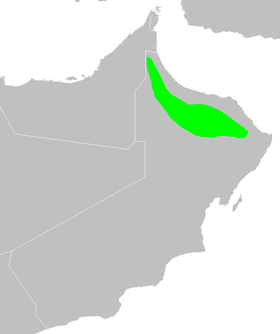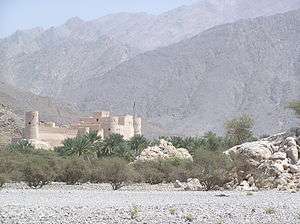Al Hajar Mountains
| Al-Hajar Mountains | |
|---|---|
 Jabal Shams, highest peak in the Hajar mountains and Oman | |
| Highest point | |
| Peak | Jabal Shams |
| Elevation | 3,009 m (9,872 ft) |
 | |
Al-Hajar Mountains (Arabic: جِـبَـال الْـحَـجَـر, translit. Jibāl al-Ḥajar, Rocky Mountains or Stone Mountains) in northeastern Oman and also the eastern United Arab Emirates are the highest mountain range in the eastern Arabian peninsula. They separate the low coastal plain of Oman from the high desert plateau, and lie 50–100 km (31–62 mi) inland from the Gulf of Oman.
"Al" (Arabic: اَلْ) means "The", and "Ḥajar" (Arabic: حَـجَـر) means "Stone" or "Rock". So "Al-Hajar" (Arabic: اَلْـحَـجَـر) would be defined as "The Stone" or "The Rock".
Geology, location and description

Geologically, Al-Hajar Mountains are the continuation of the Zagros Mountains, and were mainly formed in the Miocene and Pliocene as the Arabian Plate collided with and pushed against the Iranian Plate. These mountains are chiefly made of Cretaceous limestones and ophiolites.
The mountains begin in the north, forming the peninsula. The central section of the Hajar is the highest and wildest terrain in the country. Jebel Akhdar and the smaller Jebel Nakhl range are bounded on the east by the low Samail Valley (which leads northeast to Muscat). East of Samail are the Eastern Hajar (Hajar ash Sharqi), which run east (much closer to the coast) to the fishing town of Sur, almost at the eastern point of Oman. The mountains extend for 500 km (310 mi) in total.
The low coastal land north and east of the Jebel Hajar is called "Al-Batinah Region." The climate is cool and wet from December to March, and warmer but occasionally rainy from April to September.
Flora and fauna
The mountains are rich in plant life compared to most of Arabia, including a number of endemic species. The vegetation changes with altitude, the mountains are covered with shrubland at lower elevations, growing richer and then becoming woodland, including wild olive and fig trees between 3,630 and 8,250 ft (1,110 and 2,510 metres), and then higher still there are junipers. Fruit trees such as pomegranate and apricot are grown in the cooler valleys and in places there are rocky outcrops with little vegetation. The flora shows similarities with mountain areas of nearby Iran, as well as with areas along the Red Sea in the Horn of Africa. For example, the tree Ceratonia oreothauma is found here and also in Somalia.
A number of birds are found in the mountains including Egyptian and lappet-faced vultures (Torgos tracheliotus). Mammals include mountain gazelles (Gazella gazella) and the Arabian tahr (Arabitragus jayakari).[1][2] Other endemic species include a number of geckos and lizards: Asaccus montanus, Asaccus platyrhynchus and a subspecies of Wadi Kharrar rock gecko (Pristurus gasperetti gallagheri) are found only in Oman while Musandam leaf-toed gecko (Asaccus caudivolvulus), Gallagher's leaf-toed gecko (Asaccus gallagheri), Oman rock gecko (Pristurus celirrimus), Jayakar lizard (Lacerta jayakari) and Omman's lizard (Lacerta cyanura) are found only in the Hajar mountains. The endangered Arabian leopard (Panthera pardus nimr) had been recorded here.[3]
Threats and preservation
The Hajar are extensively grazed by domestic goats, camels and donkeys and the landscape has been cleared in parts for urban areas and for mining, which has damaged both vegetation and water supplies and uprooted traditional rural land management behaviours. Poaching of wildlife is another issue. The Oman government has created the Wadi Sareen Reserve and an area of Jebel Qahwan-Jebal Sebtah in the Eastern Hajar, for the protection of Arabian tahr and mountain gazelle. For visitors there is a road into the mountains from the town of Birkat al-Mawz (on the road to Nizwa from Muscat) and a walking route through Wadi al-Muaydin to the Saiq Plateau.
Trekking and hiking
There are 11 marked trails / routes of varying intensity (between Grade 1 to 3) and duration (between 1.5 hours to 18 hours) published by Ministry or Tourism, Oman along the Hajar Mountain range.[4]
See also
References
- ↑ Hanif, N. (2015-02-04). "Arabian Oryx thriving at Abu Dhabi sanctuary". The National. Retrieved 2018-04-03.
- ↑ "Endangered Arabian tahr born on Sir Bani Yas Island". Gulf News. 2018-01-13. Retrieved 2018-04-02.
- ↑ Spalton, J. A.; Al Hikmani, H. M. (2006). "The Leopard in the Arabian Peninsula – Distribution and Subspecies Status" (PDF). Cat News. Special Issue 1: 4–8.
- ↑ "Trekking". website. Ministry of Tourism,Sultanate of Oman.
- "Regions of Oman". Statoids.
- Gardner, 1994. A new species of Asaccus (Gekkonidae) from the mountains of northern Oman. Journal of Herpetology 28 (2): 141-145.
External links
| Wikimedia Commons has media related to Al Hajar Mountains. |
| Wikivoyage has a travel guide for Hajar Mountains. |
- "Al Hajar montane woodlands". Terrestrial Ecoregions. World Wildlife Fund.